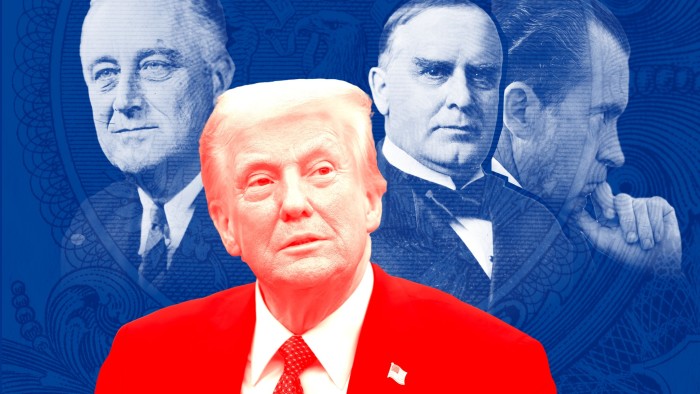In a matter of weeks, President Donald Trump’s tariff blitz has erased a century of US trade liberalisation. Economists say it could take a lot longer to build back.
Past periods of protectionism show that once trade barriers have been erected, they can prove very difficult to dismantle. “What can go up quickly does not necessarily come down fast,” said Doug Irwin, a professor at Dartmouth College who has written widely on trade.
The sweeping tariff increases of the 1930 Smoot-Hawley Act, widely seen as exacerbating the Great Depression, were soon revisited after a change of government but still “took decades to unwind”, Irwin noted.
Trump’s combination of blanket 10 per cent duties and bilateral charges will, once implemented, in effect take the tariff rate on all US imports back even further, to its highest level since 1909.
The US president himself likes to look to the preceding “gilded age” of growth and inequality, when federal income tax had not yet been invented and future president William McKinley was pushing through legislation to take average tariffs close to 50 per cent.
“We were at our richest from 1870 to 1913,” Trump said shortly after his inauguration. “That’s when we were a tariff country.”

Economists say trade wars are always costly, but that tariffs will be far more disruptive now, in an interconnected global economy where trade accounts for a much larger share of output.
The best chance of a swift de-escalation would be if the Trump administration saw the new tariffs as a negotiating tool to extract concessions in other areas, whether on trade or to serve other diplomatic objectives, said Irwin.
This is what Richard Nixon did in 1971, slapping a 10 per cent surcharge on all dutiable imports to pressure Germany and Japan to devalue their currencies. “Once that was accomplished, tariffs were off,” Irwin said.
There is still a brief window in which countries could win some reprieve from the so-called reciprocal rates — which are due to take effect on April 9 — even if the 10 per cent universal rate does not look open to negotiation.

But when tactics like Nixon’s fail to extract concessions, tariffs can stay on the books for decades.
A prime example is the 25 per cent “chicken tax” levied on US light truck imports. This was first imposed in the early 1960s, in retaliation against a European levy on factory-farmed US poultry. It was never lifted, and has reshaped the global auto industry. This was arguably to the US’s detriment, as it led US producers to specialise in gas-guzzling pick-up trucks, while being slow to expand into growth markets for smaller, fuel-efficient cars.
When tariffs are explicitly intended to protect domestic industries and reshore jobs, they are likely to prove even “stickier”, even after the original political impetus to impose them fades.
This is partly because new lobby groups spring up as industries form behind the trade barriers, and partly because “there is a government interest in negotiating and getting some quid pro quo if they reduce the tariff”, said Gary Hufbauer, a former US Treasury official and prolific author on trade, adding: “I don’t see a quick turnaround.”
Tariffs in politically sensitive areas such as agriculture are especially persistent.
“European agricultural protectionism was introduced almost everywhere in the 1870s and 1880s in the face of an invasion of cheap grain from the New World, and it is still with us today,” said Kevin O’Rourke, a professor at Sciences Po in Paris.
Coca-Cola’s US recipe tastes different from the version sold across the border in Mexico because quotas and subsidies protecting farmers in mid-western swing states have made high fructose corn syrup consistently cheaper than sugar.
This protection from cheaper imports “essentially birthed the invention and commercialisation of new products”, said Chad Bown, chief economist at the State Department under Joe Biden’s administration.
Tariffs also linger because they play well with voters.
Alexander Klein, an economic historian at Sussex University, said tariffs introduced during the US civil war to raise revenues persisted long after they were needed, because they proved popular with both the electorate and a business class happy to be protected.
“What history tells us is that voters listen more to protecting their jobs as workers, than their rights as consumers,” he said.
When the Smoot-Hawley tariffs were eventually dismantled in full after the second world war, it was because it chimed with US offensive trade interests, said Klein.
“It benefited the US, which was pressuring Europe to create a free trade area because their main market was Europe — Asia and Africa weren’t rich enough at that time,” he added.
But the factor that would make Trump’s new trade regime most likely to outlast him is if tariffs become a big source of federal revenue — as they were in their 19th century heyday.
“If they are really serious about having permanent tariffs to pay for tax cuts, that makes the tariffs a lot stickier, as you would have to raise other taxes to get rid of them,” said Jeffrey Schott, a senior fellow at the Peterson Institute for International Economics.
Kris Mitchener, professor at Santa Clara University, said that if Trump’s intention was to use tariffs as a negotiating tool or to boost domestic industry, it was doomed to failure — as it would lead other countries to retaliate, and “to view any policymaking with the US as subject to revision”.
But, he added: “If a 10 per cent universal tariff is now the baseline, and the stated goal is revenue, I don’t see them wanting to reverse it.”



